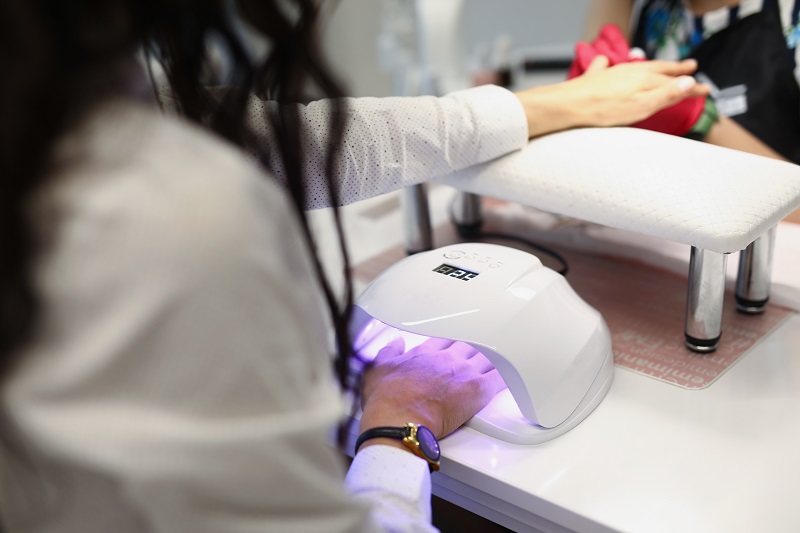Should You Skip Gel Manicures?

March 22, 2023
Gel manicures have become popular because they provide long-lasting, chip-resistant nail color. But some research suggests that the process may increase the risk of skin cancer.
Gel nail polish must be exposed to ultraviolet (UV) light in order to harden. UV lamps used at nail salons emit UV radiation, which increases skin cancer risk.
The gel manicure process only exposes the hands to radiation. By comparison, sunbathers and tanning bed users expose their entire bodies to UV radiation.
UV light – from the sun, tanning beds and other sources – increases skin cancer risk. Gel manicure lamps may raise the risk of cancer developing on the hands.
There isn’t a strong connection between getting gel manicures and developing skin cancer. But any exposure to UV radiation has the potential to raise skin cancer risk.
“People who get frequent gel manicures expose their hands to more UV radiation,” dermatologist Alexis Young, M.D. says. “Getting weekly gel manicures is riskier than going once or twice a year.”
How Gel Manicures are Different
Exposure to UV radiation is not a component of a traditional manicure. But it’s necessary for gel manicures; the UV light cures, or hardens, the polish.
After your nails are painted, you place your hands under a nail dryer. These nail dryers emit UV radiation, which sets your manicure.
“You may not associate a beauty treatment with cancer risk, but be forewarned,” Dr. Young says. “Manicures seem harmless, but gel manicures come with unexpected risks.”
UV light is associated with skin cancer and premature aging of the skin. Too much UV exposure may damage the skin’s elastin, which keeps skin looking supple.
“People usually get manicures to make their hands look more attractive,” Dr. Young says. “One result of frequent gel manicures with UV radiation could be older-looking hands.”
How to Lower Your Skin Cancer Risk if You Get Manicures
If you love gel manicures, consider changing your habits to lower your cancer risk. You can still have attractive nails without risking your safety and well-being.
Try these ideas if you can’t live without regularly scheduled gel manicures:
- Apply sunscreen to your hands. SPF 30 or 50 sunscreen should protect your skin from harmful UV radiation. Apply it at the salon, 20 minutes before using the UV nail dryer.
- Wear UV protection gloves. Several companies sell special fingerless gloves to provide UV protection during gel manicures. Gloves that cover most of the hands come in several brands and styles.
If you can get by without gel manicures all the time, try these ideas:
- Save gel manicures for special occasions. Go for gel manicures only once or twice a year, for weddings or vacations. Less exposure to UV radiation should lower your risk of skin cancer.
- Get a dip manicure instead. A dip manicure offers chip-resistant nails without exposing your hands to UV radiation. Manicurists apply base coat, dip your nails into powder, then apply activator top coat.
How to Take Better Care of Your Nails and Hands
Manicures can be easy on the eyes, yet hard on your nails. Nail polish remover and other chemicals used in the process may weaken your nails.
It’s possible to remove traditional nail polish with acetone-free polish remover. But gel and dip manicures must be removed with acetone, which is very drying.
Many nail salons ask you to soak your fingertips in acetone for 15 minutes. This may dry out the skin on your fingers, not just your nails.
To be kinder and gentler to your nails and hands:
- Skip the acetone soak. Ask for cotton balls soaked in acetone to be placed on each nail. Wrap each fingertip in foil for 15 minutes to remove polish without drying skin.
- Consider traditional polish. Your nails may chip more quickly than with gel manicures. But you’ll avoid UV radiation exposure and can use acetone-free remover.
- Take breaks between manicures. Give your nails time to recover, with a week or two without polish. Apply moisturizer to your bare nails to help them rehydrate.
Next Steps & Resources:
- Meet our source: Alexis Young, M.D.
- To make an appointment with Dr. Young, or a dermatologist near you, call 800-822-8905 or visit our website.
The material provided through HealthU is intended to be used as general information only and should not replace the advice of your physician. Always consult your physician for individual care.






